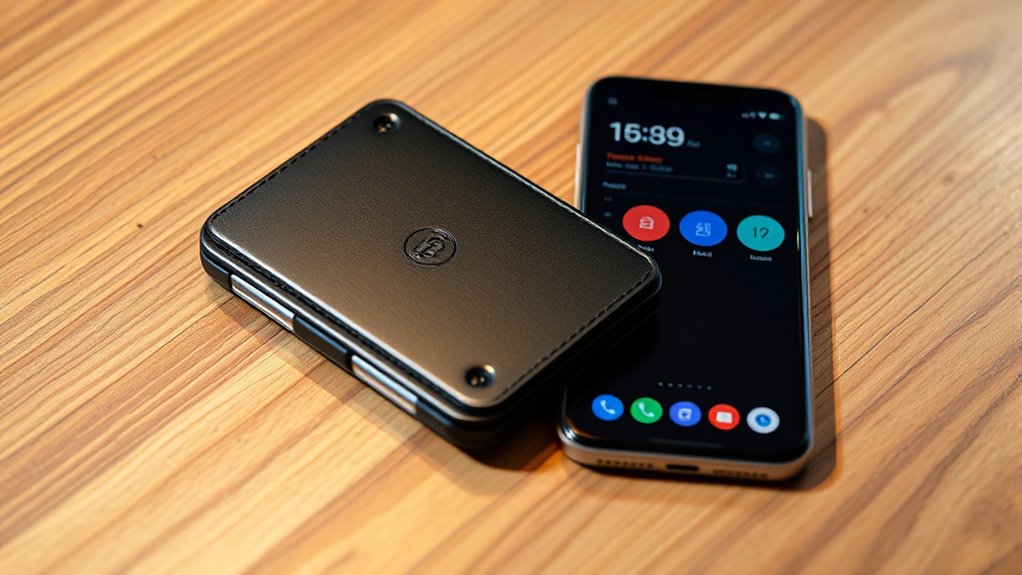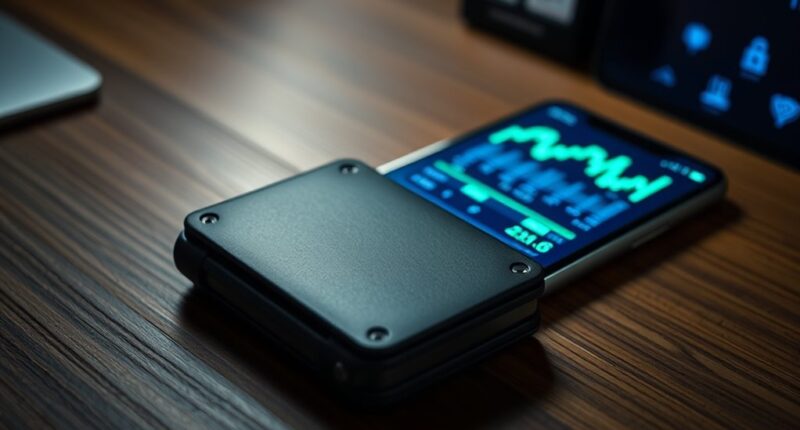Hot wallets are vulnerable to hackers because they stay connected online, making them easier targets for cyber threats. Cold wallets, by keeping your assets offline, provide a much higher level of security against hacking attempts. To protect your assets effectively, it’s best to store most funds in cold wallets and use hot wallets only for quick transactions. Want to learn how to choose the right wallet for your needs? Keep exploring to find out more.
Key Takeaways
- Cold wallets are offline, making them immune to online hacking attempts, thus offering maximum protection from hackers.
- Hot wallets are connected to the internet, increasing vulnerability to malware, phishing, and hacking threats.
- Using cold wallets for long-term storage minimizes hacker risks, while hot wallets are suitable for quick, frequent transactions.
- Proper management, like secure backups and strong passwords, enhances security regardless of wallet type.
- Combining both wallets allows for a balanced approach, optimizing security while maintaining transactional convenience.

When it comes to storing your cryptocurrencies, understanding the difference between cold wallets and hot wallets is essential. Your choice impacts your cryptocurrency security and how effectively you manage your assets. Hot wallets are connected to the internet, making them convenient for quick transactions, but they are more vulnerable to hacking. Cold wallets, on the other hand, are offline, providing a safer environment for holding large amounts of crypto over the long term. Knowing which wallet type suits your needs depends on your wallet management strategies and your risk tolerance.
Hot wallets include mobile apps, web wallets, and desktop wallets. They’re easy to access and perfect for trading or frequent transactions. However, their constant internet connectivity exposes them to the risk of malware, phishing attacks, or hacking attempts. If you’re actively trading, a hot wallet allows quick movement of funds, but you should remain cautious about security practices, such as enabling two-factor authentication and avoiding suspicious links. These measures help mitigate some risks but don’t eliminate the inherent vulnerabilities of online storage.
Cold wallets are hardware devices or paper wallets that store your crypto offline. They are immune to online hacking attempts, making them ideal for long-term storage of substantial holdings. While less convenient for daily use, cold wallets considerably enhance your overall cryptocurrency security. They are less vulnerable to phishing or malware because they aren’t connected to the internet. However, you need to ensure proper wallet management strategies—like keeping your hardware device in a secure location and backing up your keys—to prevent loss or theft. A well-maintained cold wallet can serve as a vault, safeguarding your assets against digital threats. Additionally, understanding the different projector technologies can help you better secure and optimize your investments in digital assets.
Balancing the use of both wallet types can optimize your security and flexibility. Many experienced users keep a smaller amount of crypto in hot wallets for everyday transactions and move larger holdings to cold wallets. This approach reduces exposure while maintaining accessibility. Regardless of your choice, always follow best practices for wallet management strategies—such as regularly updating your security software, using strong passwords, and keeping backups—to minimize risks.
Ultimately, the decision hinges on your priorities. If convenience is paramount and you’re comfortable managing security risks, a hot wallet might suffice. But if you’re seeking maximum protection against hackers, cold wallets offer peace of mind. Understanding these differences empowers you to make informed decisions, ensuring your cryptocurrencies remain safe from threats while aligning with your trading habits and security preferences.
Frequently Asked Questions
Can You Switch Between Cold and Hot Wallets Easily?
Switching between cold and hot wallets is generally straightforward, but it depends on your wallet security setup. Hot wallets offer user convenience with quick access, making transfers easy, while cold wallets prioritize security and require more steps to access funds. You can transfer assets between them with a few clicks or transactions, so balancing these options helps you stay flexible while maintaining wallet security. Just be mindful of the process to avoid risks.
What Are the Costs Associated With Cold and Hot Wallets?
When considering wallet security and transaction fees, cold wallets tend to have higher costs due to hardware expenses but offer better protection against hackers. Hot wallets usually have lower upfront costs and minimal transaction fees, making them more convenient for frequent use. However, they pose greater security risks. You should weigh these costs carefully, as choosing the right wallet depends on your security needs and how often you plan to transact.
How Do Wallets Protect Against Malware and Phishing Attacks?
To protect against malware and phishing attacks, you should rely on strong encryption protocols and phishing prevention techniques. Always verify website URLs, avoid clicking suspicious links, and enable two-factor authentication. Cold wallets are safer for long-term storage because they’re offline, reducing malware risk. For hot wallets, stay cautious, keep your software updated, and use security tools to detect phishing attempts, ensuring your funds stay secure from cyber threats.
Are Mobile Wallets Considered Hot or Cold Wallets?
Mobile wallets are considered hot wallets because they connect to the internet, making them more vulnerable to cyber threats. However, their hardware security features and wallet compatibility with your device help protect your funds. You should always be cautious with mobile wallets, keeping software updated and avoiding suspicious links. While convenient, remember they’re more exposed than cold wallets, which store your assets offline for maximum security.
What Is the Lifespan of a Cold Wallet Device?
Your cold wallet device’s lifespan depends on hardware security and device durability. Typically, high-quality devices last several years, often 3 to 5, with proper care. Factors like hardware quality, usage, and storage conditions influence longevity. To guarantee your assets stay protected, choose reputable brands and handle your device gently. Regular firmware updates also help maintain security, extending your cold wallet’s effective lifespan and keeping your crypto safe from potential threats.
Conclusion
Ultimately, choosing between a cold and hot wallet depends on your needs. If you want maximum security for your crypto holdings, a cold wallet is the way to go. But if you prioritize convenience and quick access, a hot wallet might suit you better. Just remember, never store all your assets in one place. Stay cautious, keep your private keys safe, and regularly review your security measures to stay protected from hackers.









